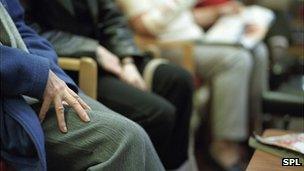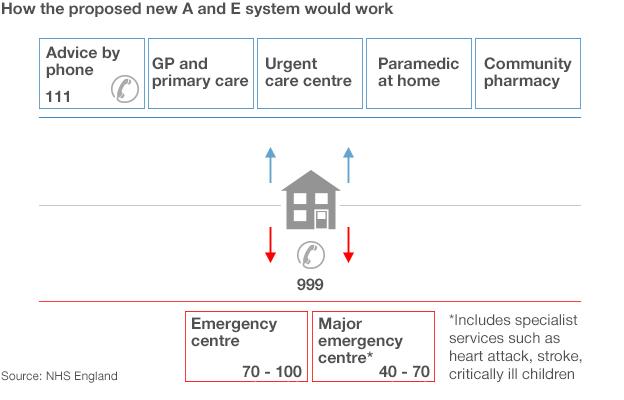Plan for two-tier A&E as part of radical shake-up
- Published
- comments

Pressures have been growing on A&E units for a number of years
A two-tier A&E system in England should be created as part of an overhaul of services, NHS chiefs say.
The review, external by NHS England suggested the biggest 40 to 70 units - specialising in heart attacks, strokes and trauma - be called major emergency centres.
It would leave the remaining 70 to 100 A&Es - known as emergency centres - to deal with less serious conditions.
It also suggested changes to the way ambulance crews and the new 111 phone service work to "decongest" A&Es.
Greater co-ordination between community services, such as GPs and pharmacists, would also help, it said.
The measures have been put forward in response to the growing pressures on accident and emergency departments.
Emergency conditions
Patient numbers have risen by 50% in the past decade and last winter the problems got so severe that the NHS missed its four-hour waiting time target.
Extra money has been set aside to help the NHS through this winter and the next one.
But this review aims to set out the long-term vision for the service.
Many of the proposals are already in operation somewhere and in essence the review is calling for this to be formalised across the system.
For example, there are already a number of A&E units that act as major centres in everything but name.
But by setting a target of having between 40 and 70 major emergency centres it means this will have to be extended across the health service.

This is likely to end up a controversial process because of the fear some hospitals could lose services.
NHS medical director Prof Sir Bruce Keogh, who led the review, said: "A&E is creaking at the seams. It is not broken, but it is struggling.
"We need to change the way we work. But what we are suggesting here already exists in places, we are just trying to formalise it so it is available for everyone."
Professor Sir Bruce Keogh: "It's about improving the outcomes for patients with very serious conditions"
The review said there also needed to be further changes to the system if pressure was going to be relieved.
About 40% of people who attend A&E do not need treating there.
What is more, the problems developed by a fifth of patients who are eventually admitted to hospital with emergency conditions could have been avoided with better and earlier treatment in the community.
The review said key to tackling these problems was ensuring patients got access to the services that were best suited to them first time.
To achieve this, 111, which has been beset by problems since it was launched in April to replace NHS Direct, will need to be much more responsive, giving patients direct phone access to doctors, nurses and other health professionals.
Ambulance crews will need to treat more patients at the scene to reduce the number of patients transferred to hospital.
Service 'creaking'
Meanwhile, there needs to be greater co-ordination between GPs, pharmacists and the network of minor injury clinics and walk-in centres to give patients 24/7 access to care outside of hospital.
Shadow Health Secretary Andy Burnham: "It's not what the government promised"
Shadow health secretary Andy Burnham said Labour welcomed Sir Bruce's report but deplored "the government's attempt to avoid presenting it to Parliament and abdicate all responsibility for the crisis in A&E".
"Ministers said this report would have lessons for the immediate winter, as well as the longer term," he added.
"But they are failing to act and their response remains 'crisis, what crisis'? They are forcing A&Es to go into winter with too few nurses, doctors and beds."
He said the prime minister had "made it harder to get a GP appointment, closed NHS walk-in centres and scrapped NHS Direct, leaving people with no alternative but to go to A&E".
Patients Association chief executive Katherine Murphy said the review had presented a "promising vision".
"At present there is genuine confusion amongst some patients, who then opt for A&E as a safe default option," she added.
College of Emergency Medicine president Dr Clifford Mann welcomed the proposals, although he said NHS chiefs would need to be careful the reorganisation of A&Es did not lead to "detrimental" increased journey times.
Dr Clare Gerada, Royal College of GPs: "We must not design the health service around the emergency department"
He also said: "Any plan to provide emergency care must be based upon an adequate number of appropriately skilled clinicians and on this matter the review is disappointingly silent."
The changes will now go out to consultation and the review team will spend the next six months looking at the cost and staffing implications before producing another report in the spring.
It is likely to take three to five years before the overhaul is completed.
- Published13 November 2013
- Published8 October 2013
- Published8 August 2013
- Published9 August 2013
- Published24 July 2013
- Published4 June 2013
- Published4 June 2013